基于LabVIEW综合实验室的设计
基于LabVIEW的虚拟实验室的研究与实现的开题报告

基于LabVIEW的虚拟实验室的研究与实现的开题报告一、研究背景及目的随着电子技术的不断发展,虚拟实验室技术已经越来越成为了实验教学和科学研究的有力工具。
虚拟实验室技术能够模拟真实的实验过程和实验环境,并且具备实验教学与科学研究的多种特性,如实验过程可控制、模拟实验数据可重复使用等。
因此,虚拟实验室技术在教育和科研领域都有着广泛的应用。
LabVIEW作为一种优秀的虚拟仪器控制软件,可以非常方便地进行仪器控制及信号采集处理。
本文旨在基于LabVIEW平台设计虚拟实验室的实验环境,实现物理实验、电子电路实验等实验教学内容的虚拟化,加强实验教学与科学研究之间的融合。
二、研究内容及技术路线针对现有实验教学中存在的诸多难题及研究目的,本文将展开以下研究内容:1. 虚拟实验室的设计与实现:采用LabVIEW软件平台,设计各类虚拟仪器的控制与信号采集等模块,实现物理实验、电子电路实验等实验教学内容的虚拟化。
2. 虚拟实验室的功能实现:简化实验操作流程,设计实验控制界面,实现虚拟实验的操作与数据采集、分析等基本功能。
3. 虚拟实验教学场景的构建:根据教学需求,构建具体的实验教学场景,实现虚拟实验的多种实验操作和实验数据展示等交互式教学场景。
技术路线如下:1. 确定实验类型及教学内容。
2. 对实验进行系统性设计,包括实验流程、数据采集、处理分析等。
3. 编写虚拟仪器控制及信号采集程序,设计实验控制界面。
4. 构建虚拟实验教学场景,实现实验交互式控制与数据展示等功能。
三、论文意义本文将利用现代化技术手段,实现虚拟实验室的基本功能,并以物理实验、电子电路实验等实验教学内容为例,构建交互性虚拟实验教学模型。
虚拟实验模型可以模拟真实实验过程和实验环境,具备实验过程可控制、模拟实验数据可重复使用等特点,可以有效提高实验教学的效果和实验数据的精度。
因此,本文对于实验教学和科学研究有着广泛的应用前景和实用价值。
基于Labview的远程虚拟电子实验室设计
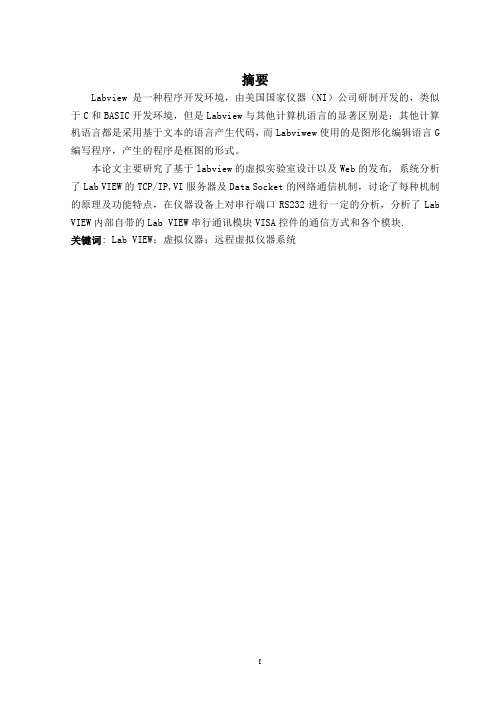
摘要Labview是一种程序开发环境,由美国国家仪器(NI)公司研制开发的,类似于C和BASIC开发环境,但是Labview与其他计算机语言的显著区别是:其他计算机语言都是采用基于文本的语言产生代码,而Labviwew使用的是图形化编辑语言G 编写程序,产生的程序是框图的形式。
本论文主要研究了基于labview的虚拟实验室设计以及Web的发布, 系统分析了Lab VIEW的TCP/IP,VI服务器及Data Socket的网络通信机制,讨论了每种机制的原理及功能特点,在仪器设备上对串行端口RS232进行一定的分析,分析了Lab VIEW内部自带的Lab VIEW串行通讯模块VISA控件的通信方式和各个模块.关键词: Lab VIEW;虚拟仪器;远程虚拟仪器系统Remote virtual E-Lab Design based on Labview Student name:Limiao teacher name:Yangxiaoping Abstract:Labview is one of the factors in program searching, it is developed aide manufactured by NI Corporation of US state, and it is similar with C and Basic exploitative environment. While there is a remarkable distinction between Labview and the other computer language, that is, the latter takes the language which is on the basis of text, then the code is produced, but Labview writes program, drawing support from graph of editor language, the program which is presents by a form of frame.To achieve such an effect, we should do well in three aspects; it will be appeared in my thesis. On the one hand, searching for the fictitious lab of programmer, and issuance of web. All which is basis of Labview.Analysing TCP/IP of Labview, VI service and net communicative system of Date socket, the third one, discussing the each of the mechanism’s principle , function and feather。
基于labview的课课程设计

基于labview的课课程设计一、教学目标本课程的教学目标是使学生掌握基于LabVIEW的实验设计和数据分析方法,培养学生的实验技能和科学探究能力。
具体目标如下:1.知识目标:学生能够理解LabVIEW的基本概念和操作方法,掌握虚拟仪器的设计原理和实现方法。
2.技能目标:学生能够运用LabVIEW设计简单的虚拟仪器,进行数据采集和分析,解决实际问题。
3.情感态度价值观目标:学生通过课程学习,培养对科学实验的兴趣和热情,增强创新意识和团队合作精神。
二、教学内容本课程的教学内容主要包括LabVIEW的基本概念、操作方法、虚拟仪器设计原理和数据分析方法。
具体安排如下:1.第一章:LabVIEW简介,介绍LabVIEW的发展历程、基本功能和应用领域。
2.第二章:LabVIEW基本操作,讲解LabVIEW的界面布局、编程环境和数据类型。
3.第三章:虚拟仪器设计,讲解虚拟仪器的概念、设计方法和实现步骤。
4.第四章:数据采集与分析,讲解数据采集原理、数据处理方法和图像显示技术。
5.第五章:实验与实践,进行实际操作练习,让学生掌握 LabVIEW 设计和数据分析方法。
三、教学方法为了提高教学效果,本课程将采用多种教学方法相结合的方式,包括:1.讲授法:讲解LabVIEW的基本概念、操作方法和虚拟仪器设计原理。
2.案例分析法:分析实际案例,让学生了解LabVIEW在各个领域的应用。
3.实验法:让学生动手实践,掌握LabVIEW操作和数据分析技巧。
4.讨论法:学生进行小组讨论,培养学生的创新思维和团队合作精神。
四、教学资源为了支持教学内容和教学方法的实施,我们将准备以下教学资源:1.教材:选用《LabVIEW教程》作为主讲教材,系统介绍LabVIEW的基本概念和操作方法。
2.参考书:提供《LabVIEW编程实践》等参考书籍,供学生深入学习。
3.多媒体资料:制作课件、视频教程等多媒体资料,帮助学生更好地理解课程内容。
毕业设计---基于LabVIEW的虚拟网络实验室的设计
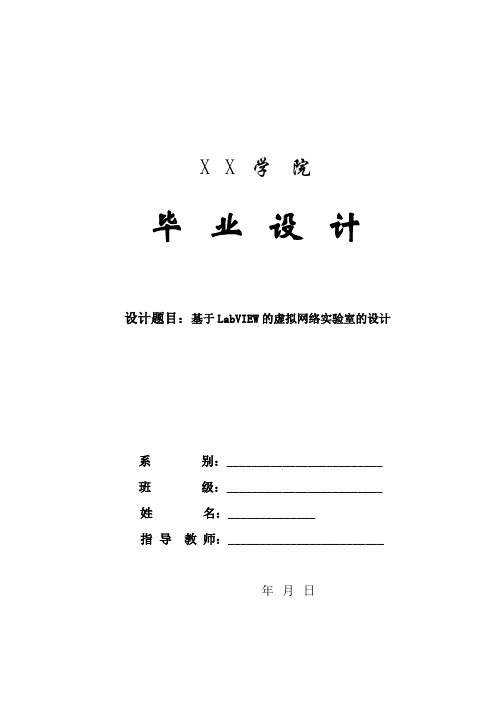
X X 学院毕业设计设计题目:基于LabVIEW的虚拟网络实验室的设计系别:_________________________ 班级:_________________________ 姓名:______________指导教师:_________________________年月日基于LabVIEW的虚拟网络实验室的设计摘要随着电子技术高速发展,普通实验室的更新速度无法跟上技术的发展。
此外普通实验室涉及到仪器调试、管理、易损坏等问题。
在实验时间和一些损耗性强的实验项目上对学生限制过死。
同样,远程教育学员一般都要在规定的时间到指定的学校集中完成实验项目.技能培养质量无法保证。
教育机构必须考虑如何跟上实验的时代性和先进性,创设实验内容丰富、训练操作扎实、不受时空限制的开放性实验环境。
近年来,由于虚拟仪器、仿真技术和网络技术的飞速发展,构建基于LabVIEW 的虚拟网络实验室将会成为一种经济、高效的首选方案。
本文的主要工作就是在LabVIEW环境下,研究基于虚拟仪器的网络教学实验系统的设计问题。
首先,本文对虚拟仪器进行概述,对比了与传统仪器的区别,介绍了虚拟仪器的软件开发平台LabVIEW的应用,以及在LabVIEW环境下进行几种常用虚拟仪器——虚拟信号发生器、相关分析、滤波器、和虚拟频谱分析仪等的软件设计方法。
接着,本文着重介绍了如何把设计的几种虚拟仪器构成一个虚拟实验室,并利用虚拟仪器技术创建一个网络虚拟实验室,充分运用网络技术构建一个网络虚拟实验系统,并采用虚拟仪器的网络通信技术实现该网络虚拟系统的远程实验目标。
本课题研究可以节省许多基础设施的重复建设和仪器设备重复引进的资金投入,有利于从整体上改善办学条件和提高教学水平。
在很大程度上方便了学生,不仅能够引导学生理解实验的理论知识,而且能够指导学生进行正确的实验操作,从而获得感性上和理性上的认识。
虚拟实验室不仅极大的弥补了远程教育模式的局限和不足,而且还使得远程教育的方式方法更趋完美。
基于LabVIEW的实验室远程监控系统设计与实现
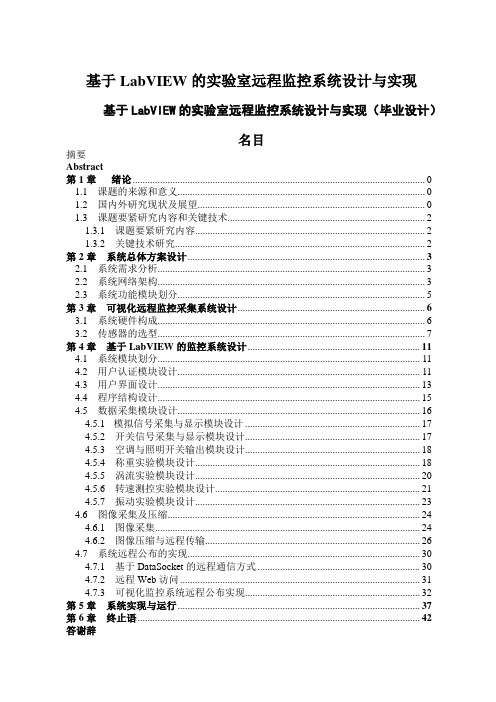
1.3.1 课题要紧研究内容............................................................................................ 2 1.3.2 关键技术研究.................................................................................................... 2 第 2 章 系统总体方案设计............................................................................................... 3 2.1 系统需求分析........................................................................................................... 3 2.2 系统网络架构........................................................................................................... 3 2.3 系统功能模块划分................................................................................................... 5 第 3 章 可视化远程监控采集系统设计........................................................................... 6 3.1 系统硬件构成........................................................................................................... 6 3.2 传感器的选型........................................................................................................... 7 第 4 章 基于 LabVIEW 的监控系统设计..................................................................... 11 4.1 系统模块划分......................................................................................................... 11 4.2 用户认证模块设计................................................................................................. 11 4.3 用户界面设计......................................................................................................... 13 4.4 程序结构设计......................................................................................................... 15 4.5 数据采集模块设计................................................................................................. 16 4.5.1 模拟信号采集与显示模块设计 ...................................................................... 17 4.5.2 开关信号采集与显示模块设计...................................................................... 17 4.5.3 空调与照明开关输出模块设计...................................................................... 18 4.5.4 称重实验模块设计.......................................................................................... 18 4.5.5 涡流实验模块设计.......................................................................................... 20 4.5.6 转速测控实验模块设计.................................................................................. 21 4.5.7 振动实验模块设计.......................................................................................... 23 4.6 图像采集及压缩..................................................................................................... 24 4.6.1 图像采集.......................................................................................................... 24 4.6.2 图像压缩与远程传输...................................................................................... 26 4.7 系统远程公布的实现............................................................................................. 30 4.7.1 基于 DataSocket 的远程通信方式 ................................................................. 30 4.7.2 远程 Web 访问 ................................................................................................ 31 4.7.3 可视化监控系统远程公布实现...................................................................... 32 第 5 章 系统实现与运行................................................................................................. 37 第 6 章 终止语 ................................................................................................................. 42 答谢辞
Lab View 综合设计实验报告-简易计算器
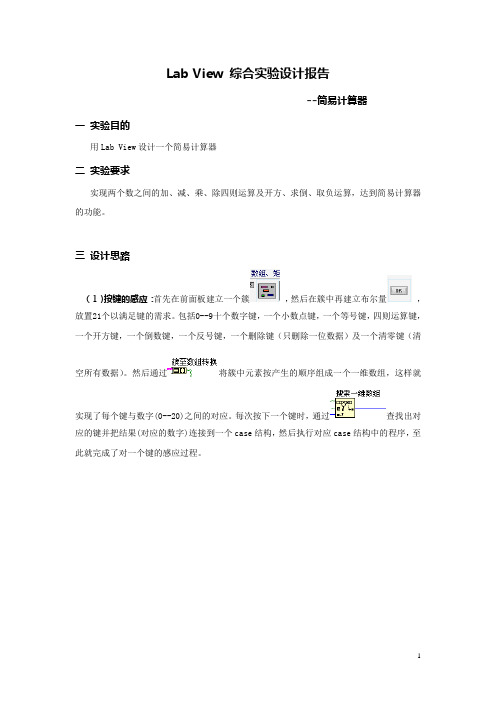
Lab View 综合实验设计报告--简易计算器一实验目的用Lab View设计一个简易计算器二实验要求实现两个数之间的加、减、乘、除四则运算及开方、求倒、取负运算,达到简易计算器的功能。
三设计思路(1)按键的感应:首先在前面板建立一个簇,然后在簇中再建立布尔量,放置21个以满足键的需求。
包括0--9十个数字键,一个小数点键,一个等号键,四则运算键,一个开方键,一个倒数键,一个反号键,一个删除键(只删除一位数据)及一个清零键(清空所有数据)。
然后通过将簇中元素按产生的顺序组成一个一维数组,这样就实现了每个键与数字(0--20)之间的对应。
每次按下一个键时,通过查找出对应的键并把结果(对应的数字)连接到一个case结构,然后执行对应case结构中的程序,至此就完成了对一个键的感应过程。
前面板设计:后面板设计:(2)数字的读入:具体赋给哪个操作数通过布尔量change的状态决定,该布尔量状态在输入运算类型键后改变。
这里要注意的是:在第二个数键入时,要把结果赋给num3,最终是在num1和 num3之间进行运算运算,这样做是为了在一种运算结束后能实现连续的运算。
数字读入程序框图(3)操作类型:当按下运算类型键时,存储对应的数字序号到type,以按下“=”号时进行运算类型的确定。
操作类型默认为“空”。
在此操作类型case中同时执行对change状态转换。
在其中再用一个case结构用于实现“+、-、*、/”的连续运算。
(4)等号键:在11键的case中实现加、减、乘、除、开方及倒数运算。
连续按此键可以实现第一操作数对第二操作数的连续运算。
等号键程序框图四寄存器及布尔变量的作用num1用来存储第一个输入数据。
第二个输入数据存入num2中,然后将其赋给 num3,并使num2为空,以便输入的数据存入num2,所有的运算是在num1和 num3间进行,运算结果都赋给num1和result。
change用来判断是第一个数据还是第二个数据。
基于labview的课程设计

基于labview的课程设计一、教学目标本课程旨在通过LabVIEW软件的使用,让学生掌握数据采集、信号处理和仪器控制等方面的知识,培养学生具备实际操作能力和创新思维。
具体目标如下:1.知识目标:(1)了解LabVIEW软件的基本功能和操作界面。
(2)掌握LabVIEW中的数据采集、信号处理和仪器控制等基本原理。
(3)熟悉LabVIEW编程技巧,能够编写简单的程序。
2.技能目标:(1)能够熟练操作LabVIEW软件,进行数据采集和信号处理。
(2)能够运用LabVIEW实现简单的仪器控制功能。
(3)能够独立完成LabVIEW程序的编写和调试。
3.情感态度价值观目标:(1)培养学生对科学实验的兴趣和热情。
(2)培养学生团队合作精神,提高学生解决实际问题的能力。
(3)培养学生具备创新意识,激发学生探索科学奥秘的欲望。
二、教学内容本课程的教学内容主要包括LabVIEW软件的基本操作、数据采集、信号处理和仪器控制等方面的知识。
具体安排如下:bVIEW软件的基本操作:包括软件的安装、界面认识、基本功能介绍等。
2.数据采集:包括虚拟仪器的创建、数据采集原理、数据处理方法等。
3.信号处理:包括信号发生器、波形显示、信号分析等。
4.仪器控制:包括控制原理、通信接口、控制系统设计等。
三、教学方法本课程采用讲授法、实验法、讨论法等多种教学方法,以激发学生的学习兴趣和主动性。
1.讲授法:用于向学生传授LabVIEW软件的基本原理和操作方法。
2.实验法:让学生亲自动手操作LabVIEW软件,进行数据采集和信号处理,培养实际操作能力。
3.讨论法:分组讨论实验结果,引导学生思考和解决问题,提高学生的创新思维。
四、教学资源1.教材:选用《LabVIEW编程与应用》作为主要教材,为学生提供系统性的知识学习。
2.实验设备:配备计算机、LabVIEW软件、数据采集设备等,为学生提供实践操作的机会。
3.多媒体资料:制作课件、视频等资料,丰富教学手段,提高学生的学习兴趣。
基于LabVIEW的智慧实验室的设计与实现
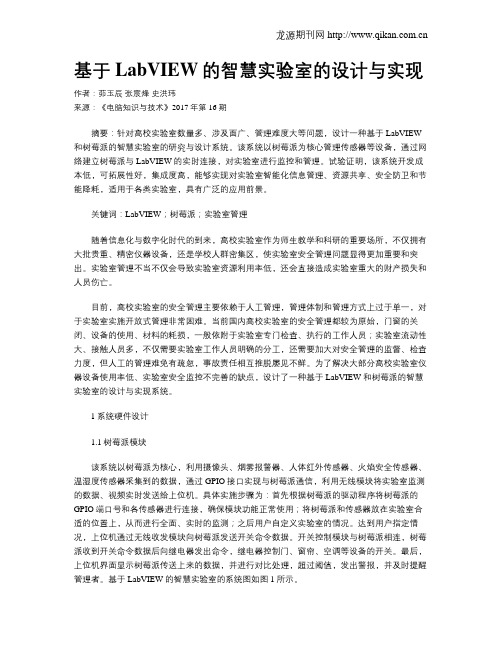
基于LabVIEW的智慧实验室的设计与实现作者:茆玉辰张宸烽史洪玮来源:《电脑知识与技术》2017年第16期摘要:针对高校实验室数量多、涉及面广、管理难度大等问题,设计一种基于LabVIEW 和树莓派的智慧实验室的研究与设计系统。
该系统以树莓派为核心管理传感器等设备,通过网络建立树莓派与LabVIEW的实时连接,对实验室进行监控和管理。
试验证明,该系统开发成本低,可拓展性好,集成度高,能够实现对实验室智能化信息管理、资源共享、安全防卫和节能降耗,适用于各类实验室,具有广泛的应用前景。
关键词:LabVIEW;树莓派;实验室管理随着信息化与数字化时代的到来,高校实验室作为师生教学和科研的重要场所,不仅拥有大批贵重、精密仪器设备,还是学校人群密集区,使实验室安全管理问题显得更加重要和突出。
实验室管理不当不仅会导致实验室资源利用率低,还会直接造成实验室重大的财产损失和人员伤亡。
目前,高校实验室的安全管理主要依赖于人工管理,管理体制和管理方式上过于单一,对于实验室实施开放式管理非常困难。
当前国内高校实验室的安全管理都较为原始,门窗的关闭、设备的使用、材料的耗损,一般依附于实验室专门检查、执行的工作人员;实验室流动性大、接触人员多,不仅需要实验室工作人员明确的分工,还需要加大对安全管理的监督、检查力度,但人工的管理难免有疏忽,事故责任相互推脱屡见不鲜。
为了解决大部分高校实验室仪器设备使用率低、实验室安全监控不完善的缺点,设计了一种基于LabVIEW和树莓派的智慧实验室的设计与实现系统。
1系统硬件设计1.1树莓派模块该系统以树莓派为核心,利用摄像头、烟雾报警器、人体红外传感器、火焰安全传感器、温湿度传感器采集到的数据,通过GPIO接口实现与树莓派通信,利用无线模块将实验室监测的数据、视频实时发送给上位机。
具体实施步骤为:首先根据树莓派的驱动程序将树莓派的GPIO端口号和各传感器进行连接,确保模块功能正常使用;将树莓派和传感器放在实验室合适的位置上,从而进行全面、实时的监测;之后用户自定义实验室的情况。
基于LabVIEW的实验教学系统的设计

1.绪论1. 1课题背景在电工及电子类课程中,实验是一种重要的教学手段,学生通过做实验,可以加深对所学知识的理解,增强学习的兴趣,提高动手能力,锻炼在实践中发现问题、分析问题和解决问题的能力。
但是,近年来各大高校纷纷扩招,学生人数急剧增加,实验室的设备和规模都难以满足需要,实验室常规设备有的己经老化,有的技术上有些落后,在当前学校经费较少的情况下,如果大量增加常规仪器、仪表的配置,学校财力难以支付。
又因为基础实验室是面向所有的工科专业,任务异常繁重,实验室常常只能应付学生按教学大纲要求做一些最简单的验证实验,学生很少有机会去反复熟悉常用仪器仪表的使用,更很少有机会做设计性实验,这对调动学生积极性,培养创新精神,加强实践动手能力都十分不利。
虚拟仪器的出现很好的解决了这个问题。
美国国家仪器公司(National Instruments)在20世纪80年代最早提出虚拟仪器(Virtual Instrument)的概念,同时推出了用于虚拟仪器开发的工程软件包LabVIEW。
NI公司宣称“The Software is the Instrument”,即“软件就是仪器”[1]。
虚拟仪器利用现有的计算机,加上特殊设计的仪器硬件和专用软件,形成既有普通仪器的基本功能,又有一般仪器所没有的特殊功能的高档低价的新型仪器。
虚拟仪器是计算机技术与电子仪器相结合而产生的一种新的仪器模式。
它通常是由个人计算机、模块化的功能硬件与用于数据分析、过程通信及图形用户界面的应用软件有机结合构成,使计算机成为一个具有各种测量功能的数字化测量平台。
它利用软件在屏幕上生成各种仪器面板,完成对数据的处理、表达、传送、存储、显示等功能。
虚拟仪器的出现是仪器发展史上的一场革命,代表着仪器发展的最新方向和潮流,对科学技术的发展和工业生产的进步将产生不可估量的影响,同时对改善高校实验教学仪器设备,提高教学质量也是一个福音。
在虚拟仪器系统中,用计算机灵活强大的软件代替传统仪器的某些部件,用人的智力资源代替许多物质资源,通过一组软件和硬件,形成既有普通仪器的基本功能,又有一般仪器所不具备的特殊功能的新型仪器结合数据库技术和软件技术,可以在虚拟仪器的基础上形成虚拟仪器实验室。
基于LabVIEW的实验系统设计
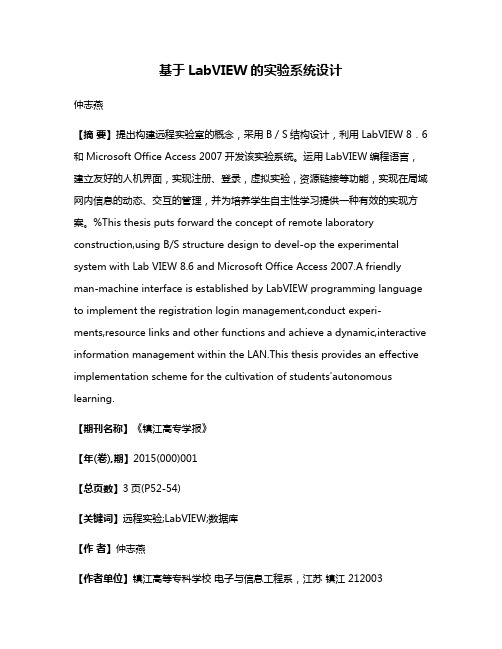
基于LabVIEW的实验系统设计仲志燕【摘要】提出构建远程实验室的概念,采用B/S结构设计,利用LabVIEW 8.6和Microsoft Office Access 2007开发该实验系统。
运用LabVIEW编程语言,建立友好的人机界面,实现注册、登录,虚拟实验,资源链接等功能,实现在局域网内信息的动态、交互的管理,并为培养学生自主性学习提供一种有效的实现方案。
%This thesis puts forward the concept of remote laboratory construction,using B/S structure design to devel-op the experimental system with Lab VIEW 8.6 and Microsoft Office Access 2007.A friendly man-machine interface is established by LabVIEW programming language to implement the registration login management,conduct experi-ments,resource links and other functions and achieve a dynamic,interactive information management within the LAN.This thesis provides an effective implementation scheme for the cultivation of students'autonomous learning.【期刊名称】《镇江高专学报》【年(卷),期】2015(000)001【总页数】3页(P52-54)【关键词】远程实验;LabVIEW;数据库【作者】仲志燕【作者单位】镇江高等专科学校电子与信息工程系,江苏镇江 212003【正文语种】中文【中图分类】TP391.412虚拟教学模式突破了时间和空间的局限,学习者可以在任何时间、任何地点学习,教与学更加灵活。
基于LabVIEW的《控制工程》虚拟实验室设计
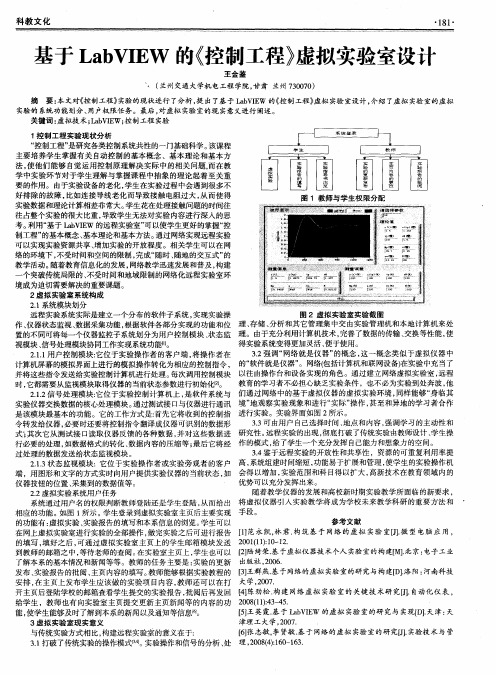
20. 了解本系的基本情况和新 闻等等 。教师的任务主要是 : 实验 的更新 出版 社 .0 6 3Y群 基于 网络的虚拟实验 室的研 究与构 建【 ] D. 洛阳 : 南科技 河 发布 、 实验报告 的批 阅、 主页 内容 的填写。 教师能够根据实验教程 的 []- 燕. 20. 安排 , 主页上 发布学生应该做 的实验项 目内容 , 还可以在打 大 学 ,0 7 在 教师 4 陈劲松 . 构建 网络 虚拟 实验 室的 关键 技术研 究『. J 自动化仪 表 , 1 开 主页后登陆学校的邮箱查看学生提交的实验报告 , 阅后再发 回 【】 批
给学生 ,教师也有 向实验 室主页提交更新主页新 闻等 的 内容 的功 2 0 (1: - 5 0 81) 3 4 . 4 【1 5王英 霞. 基于 L b lW 的虚拟 实验 室的研 究与 实现 f1 津: aV E D. 天 天 能, 使学生 能够及时 了解到本 系的新 闻以及通知等信息问 。 津理工大学 ,0 7 20 . , 3虚拟实验室现实意义 【1 6张志敏, 贤敏. 于网络 的虚拟 实验 室的研 究【 . 李 基 J 实验技 术与 管 】 与传统实验方式相 比, 构建远程实验室的意义在于:
实验的 系统功能划分 、 用户权限任务。最后 , 对虚拟 实验 室的现 实意义进行 阐述 。 关键词 : 虚拟技 术;a VE 控制工程 实验 Lb I W;
基于LabVIEW的通信原理虚拟实验室设计毕业论文
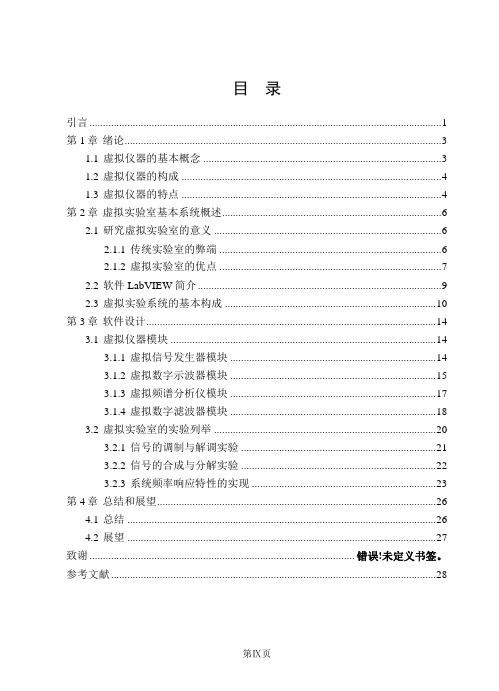
目录引言 (1)第1章绪论 (3)1.1 虚拟仪器的基本概念 (3)1.2 虚拟仪器的构成 (4)1.3 虚拟仪器的特点 (4)第2章虚拟实验室基本系统概述 (6)2.1 研究虚拟实验室的意义 (6)2.1.1 传统实验室的弊端 (6)2.1.2 虚拟实验室的优点 (7)2.2 软件LabVIEW简介 (9)2.3 虚拟实验系统的基本构成 (10)第3章软件设计 (14)3.1 虚拟仪器模块 (14)3.1.1 虚拟信号发生器模块 (14)3.1.2 虚拟数字示波器模块 (15)3.1.3 虚拟频谱分析仪模块 (17)3.1.4 虚拟数字滤波器模块 (18)3.2 虚拟实验室的实验列举 (20)3.2.1 信号的调制与解调实验 (21)3.2.2 信号的合成与分解实验 (22)3.2.3 系统频率响应特性的实现 (23)第4章总结和展望 (26)4.1 总结 (26)4.2 展望 (27)致谢............................................................................................... 错误!未定义书签。
参考文献 (28)引言在这个计算机和网络时代,利用计算机和网络技术对传统的产业进行改造,已是大势所趋,而虚拟仪器系统正是计算机和网络技术与传统的仪器技术进行融合的产物。
八十年代末,美国国家仪器公司(NI)提出了“软件就是仪器”的口号,将日益普及的计算机技术与仪器仪表技术完美结合起来,提出虚拟仪器(Virtual Instruments)的概念。
LabVIEW是Laboratory Virtual Instrument Engineering Workbench 的缩写。
它是NI 公司研制的图形化编程软件,是目前最为成功、应用最为广泛的虚拟仪器软件开发环境。
应用虚拟仪器技术,使我们能够在计算机上按照自己的需求来设计仪器,方便灵活而且开发周期短。
基于Labview的虚拟实验室

Labview在虚拟实验室中的挑战
技术门槛高
Labview作为一款较为专业的虚 拟仪器开发平台,对使用者的编 程技能和仪器控制技能要求较高 ,对于初学者来说存在一定的学
习门槛。
实验资源有限
Labview的虚拟实验室中,实验 资源相对有限,实验项目数量和 种类相对较少,不能满足所有学
科领域的需求。
实时性不足
Labview可以连接各种传感器和实验设备, 进行实时数据采集和分析,帮助学生了解 实验过程中的数据变化和规律。
学生可以使用Labview的图形化编程语言, 设计和实现各种算法,如滤波、控制、信 号处理等。
远程实验
创新应用
通过Labview的网络功能,学生可以在任何 地点和时间进行虚拟实验,不受地点和时 间的限制。
基于Labview的电子电路虚拟实验室
1 2
基础电子电路实验
包括电阻、电容、电感等基本电子元件的测量和 设计。
模拟电路实验
如放大器、振荡器等模拟电路的设计和调试。
3
数字电路实验
如逻辑门、触发器等数字电路的设计和调试,同 时也可以通过Labview实现微控制器的控制。
05
Labview在虚拟实验室 中的挑战与未来发展
Labview虚拟实验室是一种利用Labview构建的虚拟实验平台,可以模拟实验设备 、实验过程和实验结果,从而帮助学生更好地理解和掌握实验知识。
02
Labview在虚拟实验室 中的应用
Labview在虚拟实验室中的应用
• 请输入您的内容
03
Labview在实验教学中 的创新应用
实验教学内容与目的
Labview在处理实时性要求较高 的实验时,可能存在一定的延迟 和误差,影响实验结果的准确性
labview 实验室⑤
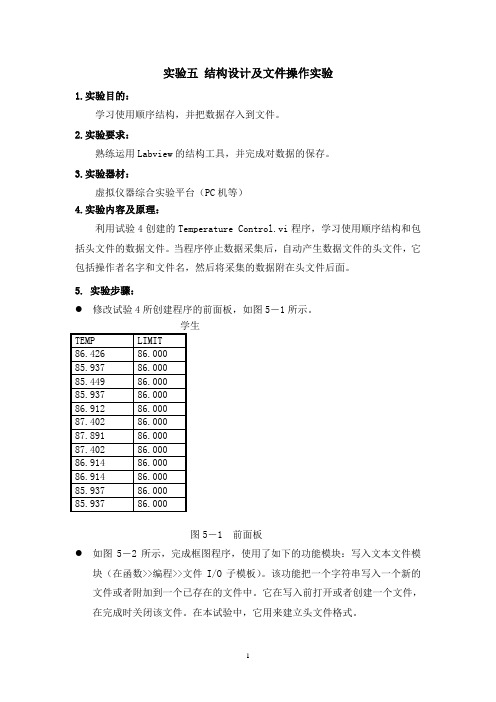
实验五结构设计及文件操作实验1.实验目的:学习使用顺序结构,并把数据存入到文件。
2.实验要求:熟练运用Labview的结构工具,并完成对数据的保存。
3.实验器材:虚拟仪器综合实验平台(PC机等)4.实验内容及原理:利用试验4创建的Temperature Control.vi程序,学习使用顺序结构和包括头文件的数据文件。
当程序停止数据采集后,自动产生数据文件的头文件,它包括操作者名字和文件名,然后将采集的数据附在头文件后面。
5. 实验步骤:●修改试验4所创建程序的前面板,如图5-1所示。
学生TEMP LIMIT86.426 86.00085.937 86.00085.449 86.00085.937 86.00086.912 86.00087.402 86.00087.891 86.00087.402 86.00086.914 86.00086.914 86.00085.937 86.00085.937 86.000图5-1 前面板●如图5-2所示,完成框图程序,使用了如下的功能模块:写入文本文件模块(在函数>>编程>>文件I/O子模板)。
该功能把一个字符串写入一个新的文件或者附加到一个已存在的文件中。
它在写入前打开或者创建一个文件,在完成时关闭该文件。
在本试验中,它用来建立头文件格式。
a 顺序0b 顺序1图5-2 框图程序●写入电子表格文件模块(在文件I/O子模块)。
该模块把一个二维或者一维单精度数组转换成字符串,并把字符串写入一个新文件或者附回在一个已存在的文件后面。
在本试验中,它将由“温度采集数据”和“上限值”组成的二维数组附加在一个已创建了头文件的数据文件后面。
●二维数组转置模块(在数组子模板)。
在本试验中,它把二维数组转换成以列为分界的二维数组,这样在写入数据文件时它就会以列的形式显示。
●连接字符串模块(在字符串子模板)。
在本试验中,它用于创建头文件字符串。
●顺序结构程序按指定的顺序执行各个程序步骤。
基于LabVIEW的网络虚拟实验室设计

基于LabVIEW的网络虚拟实验室设计0 引言随着招生规模的不断扩大,国内普通高等院校实验设备往往比较陈旧,不能及时更新,从而无法跟上教育的飞速发展。
目前,高等工科院校仍沿用传统的实验教学方法,实验内容侧重于理论验证和模仿训练,缺乏对学生创新意识的培养和综合能力的提高。
滞后的实验设备和死板的实验模式难以调动学生的主动性和创造性,实验教学处于应试教育。
而虚拟实验室系统则主要依赖于软件和较少的配套硬件,使实验室的维护费用和工作量大大降低。
LabVIEW 作为虚拟仪器开发系统的代表,可以利用Internet 进行虚拟实验室的网络发布,实现了资源共享,避免了仪器重复添置,满足了用户不再受时间、地点限制进行远程的实时合作,提高了用户的学习效果。
1 系统的总体目标本系统的总体目标是设计并实现一个基于局域网的虚拟实验平台,该虚拟实验平台主要完成模拟电路和数字电路的仿真和数据采集等实验,使学生可以通过网络完成大学相关课程的规定实验,突破地域和时间上的限制,达到网络实验教学的目的。
学生是虚拟实验室的最终用户,每个用户以自己的学号和密码作为出入虚拟实验室的通行证,登录虚拟实验室系统后,可以在客户端进行相关的实验操作。
在虚拟实验室中,用户可以选择实验,选择实验仪器,进行实验仿真、数据分析。
2 虚拟实验室的设计与实现系统采用GPIB(general purpose interface bus)仪器控制技术,将可程控仪器连接到LabVIEW 仪器控制服务器上,实现仪器的本地控制,并利用网络技术,把所提供的实验题目及内容放入建立的网站上,远程用户只需利用网络浏览器,就可以登录到远程实验室的网络服务器上,进行实验操作,远程控制实验仪器。
在远程实验室的主页上,还可以加入视频摄像部分。
由视频头所采集的图像可通过视频压缩传输技术传送到网页上,这样用户就可以看到自己所操纵的精密仪器,直接从屏幕上看到实验结。
用NI USRP和LabVIEW为实验室设计实践课程
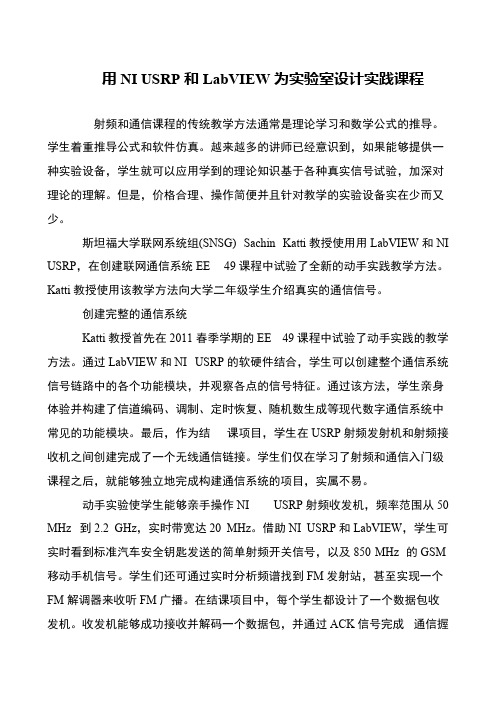
用NI USRP和LabVIEW为实验室设计实践课程 射频和通信课程的传统教学方法通常是理论学习和数学公式的推导。
学生着重推导公式和软件仿真。
越来越多的讲师已经意识到,如果能够提供一种实验设备,学生就可以应用学到的理论知识基于各种真实信号试验,加深对理论的理解。
但是,价格合理、操作简便并且针对教学的实验设备实在少而又少。
斯坦福大学联网系统组(SNSG) Sachin Katti教授使用用LabVIEW和NI USRP,在创建联网通信系统EE 49课程中试验了全新的动手实践教学方法。
Katti教授使用该教学方法向大学二年级学生介绍真实的通信信号。
创建完整的通信系统 Katti教授首先在2011春季学期的EE 49课程中试验了动手实践的教学方法。
通过LabVIEW和NI USRP的软硬件结合,学生可以创建整个通信系统信号链路中的各个功能模块,并观察各点的信号特征。
通过该方法,学生亲身体验并构建了信道编码、调制、定时恢复、随机数生成等现代数字通信系统中常见的功能模块。
最后,作为结课项目,学生在USRP射频发射机和射频接收机之间创建完成了一个无线通信链接。
学生们仅在学习了射频和通信入门级课程之后,就能够独立地完成构建通信系统的项目,实属不易。
动手实验使学生能够亲手操作NI USRP射频收发机,频率范围从50 MHz 到2.2 GHz,实时带宽达20 MHz。
借助NI USRP和LabVIEW,学生可实时看到标准汽车安全钥匙发送的简单射频开关信号,以及850 MHz 的GSM 移动手机信号。
学生们还可通过实时分析频谱找到FM发射站,甚至实现一个FM解调器来收听FM广播。
在结课项目中,每个学生都设计了一个数据包收发机。
收发机能够成功接收并解码一个数据包,并通过ACK信号完成通信握。
基于labview数字信号处理虚拟实验室设计开题报告.doc

基于labview数字信号处理虚拟实验室设计开题报告.docAAAAA 大学毕业设计(论文)开题报告题目基于labview信号分析虚拟实验室学院名称专业班级学生姓名学号指导教师填表时间:年月日填表说明1.开题报告作为毕业设计(论文)答辩委员会对学生答辩资格审查的依据材料之一。
2.此报告应在指导教师指导下,由学生在毕业设计(论文)工作前期完成,经指导教师签署意见、相关系主任审查后生效。
3.学生应按照学校统一设计的电子文档标准格式,用A4纸打印。
4.参考文献不少于8篇,其中应有适当的外文资料(一般不少于2篇)。
5.开题报告作为毕业设计(论文)资料,与毕业设计(论文)一同存档。
设计(论文)题目基于虚拟仪器的稳态电能质量分析与检测设计(论文)类型(划“√”)工程设计应用研究开发研究基础研究其它√一、本课题的研究目的和意义目的主要使用图形化编程语言LabVIEW来设计规则波形发生器,实现产生正弦信号、锯齿信号、三角信号、方波信号的功能。
同时,可以根据实际的需要,设置不同的设备号、通道号,信号频率、信号幅值、补偿值、初始相位、占空比并能设计实现信号的时域分析频域分析意义随之计算机技术的发展,利用软件进行信号处理的应用日益广泛。
以开发的用于虚拟仪器的数字信号处理和图像处理软件的功能也日益强大。
具有高度的稳定性,灵活性,精确性,能实现高精度和大动态范围的信号分析。
二、本课题的主要研究内容(提纲)(1)学习Labview编程语言,掌握基本的函数设计和模块设计。
(2)学习信号发生器的相关知识,了解各参数的意义和定义。
(3)使用Labview编程实现正弦信号、锯齿信号、三角信号、方波信号的功能。
同时,可以根据实际的需要,设置不同的设备号、通道号,信号频率、信号幅值、补偿值、初始相位、占空比。
(4)学习信号频域分析系统的相关知识,了解各参数的意义和定义。
(5)使用Labview编程实现幅频特性和相频特性等计算分析。
(6)学习信号时域分析系统的相关知识,了解各参数的意义和定义。
- 1、下载文档前请自行甄别文档内容的完整性,平台不提供额外的编辑、内容补充、找答案等附加服务。
- 2、"仅部分预览"的文档,不可在线预览部分如存在完整性等问题,可反馈申请退款(可完整预览的文档不适用该条件!)。
- 3、如文档侵犯您的权益,请联系客服反馈,我们会尽快为您处理(人工客服工作时间:9:00-18:30)。
外文文献译文设计(论文)题目: 基于LabVIEW综合实验室的设计专业与班级:学生姓名:指导教师:LabVIEW1.overviewLabVIEW is a program development environment, by the national instruments (NI) research and development company, similar to the C and BASIC development environment, but with other computer language LabVIEW significant difference is: other computer language is based on the text, and the language code of graphical LabVIEW use scripting language G program, application is in the form of block diagram.A complete, LabVIEW virtual instrument system of open application software development, and use it to form instrument testing system and data collecting system can simplify the design procedure. With Visual C++ LabVIEW, Visual Basic,LabWindows/CVI, etc, which adopts different programming language is based on the text language program Code (Code), and abVIEW L is using graphical programming language), Graphic (G instead of the traditional diagram of the Code. The Lab VIEW of equipment with the scientists and engineers icon in the habit of basic agreement, this makes the icon programming process and thinking process is very similar.LabVIEW convenient calls Windows DLL and user-defined function in the DLL, LabVIEW also provides CIN (C) Node with any users can use by C + + language or, if the ANSI C, compiled program modules, makes a open LabVIEW development platform. LabVIEW also directly support dynamic data exchange (DDE), structured query language (SQL), TCP and UDP network protocol. In addition, the LabVIEW also provides special used for program development kit, users can easily set breakpoints, dynamic program execution to very intuitive image observation data transmission process, and convenient debug.The operation mechanism is LabVIEW macroeconomic sense is no longer the von neumann traditionally computer system structure of the method. The traditional computer language (such as C) to the order of execution by parallel structure in LabVIEW mechanism; Essentially, it is a kind of control Flow structure with graphical Data Flow pattern (Data Flow Mode), this kind of means to ensure the process of any Node Function in hire those knowledgeable programmers only after all it can only be executed Data.That is to say, in the data flow in the concept of program execution, and it is the data driven by operating system, calculate machine and so on.Since LabVIEW program is data flow driven, data flow design program, a goal only when it's all input can only be effective, And the goal of output only when it is complete. So, in VIEW of the Lab is connected the data flow between nodes function control program execution sequence, and don't like text program execution sequence by rows of constraint. Thus, we can be connected through the rapid development of concise function node applications, even can have multiple data synchronization operation channel, the so-called Multithreading (Multithreading).2.Data Storage and Reporting with NI LabVIEWThe continued increase in processing and storage capacity and the decrease of hardware and software costs has resulted in an explosion of collected data being acquired. But while technology is enabling faster and richer data retention, storing, managing, and sharing data remains the real challenge. Traditional software packages tend to take one of two limiting approaches: 1) they force you into a particular format that is not exchangeable with other applications or users or 2) saving data is left so open ended you waste time trying to determine the best way to organize and save your data to disk so you can share it.NI LabVIEW, designed for the entire engineering process, includes built-in functionality to help you easily save data to disk and create professional reports. By providing easy yet robust interfaces for file I/O and reporting, you can make the most of your acquired data to make decisions faster.(1)File I/O Designed Specifically for Engineering DataDespite the fact that LabVIEW offers a wide variety of file I/O options, these traditional file types rarely meet all the criteria you need in a file format. For example, ASCII files are exchangeable, but are very large and slow to read and write. On the other hand, binary file read and write speeds can keep up with high-speed hardware, but are difficult to share with others.Because of the drawbacks of traditional file I/O, National Instruments developed the Technical Data Management Streaming (TDMS) file format to meet the specific needs and high demands of engineers and scientists. TDMS files are based on the TDM data model for saving well-organized and documented test and measurement data. The TDM data model offers three levels of hierarchy, as shown in Figure 2 – file, group, and channel. The file level can contain an unlimited number of groups, andeach group can contain and unlimited number of channels. Because of this channel grouping, you can organize your data to make it easier to understand. For example, you may have one group for your raw data and another group for your analyzed data within one file, or you may have multiple groups that correspond to sensor types or locations.Figure 1. The TDM data model meets the specific requirements of measurementdata.Also, you can insert your own custom properties at each of the three levels. Each level accepts an unlimited number of custom-defined attributes to achieve well-documented and search-ready data files. The descriptive information located in the TDMS file, a key benefit of this model, provides an easy way to document the data much like you would document code. As your documentation requirements increase, you do not have to redesign your application, you simply extend the data model to meet your needs.(2)Multiple Easy-to-Use Programming InterfacesBecause it was developed to meet the needs of all engineers, TDMS offers ease of use, high-speed streaming, and exchangeability. Like many operations in LabVIEW, you can use multiple interfaces to write TDMS files. You can quickly read and write TDMS files using a virtual instrument (VI) such as the Write To Measurement File Express VI or, for the best performance and customization, use the primitive TDMS VIs from the File I/O palette. Also, when using LabVIEW with NI-DAQmx, you can use the Configure Logging VI from the DAQ palette or log directly from the NI DAQ Assistant(3)Files Exchangeable with Other Programs such as Microsoft ExcelBecause you may be required to work in additional applications, TDMS is easilyexchangeable across other programs. You can open TDMS files in Microsoft Excel using the TDM Excel Add-In, which installs with NI software and is available free at . You also can use a C DLL for reading and writing TDMS files in other programming languages. NI is committed to helping you write well-organized and documented data using the TDMS file format, regardless of which products you use.(4)Custom and Legacy File Format Reading and WritingAlthough ideally you can choose the file format for each application you work on, you may still be restricted to reading and writing in a custom format due to legacy files or hardware that uses custom formats. Understanding that many engineers face this challenge, NI developed the DataPlugin technology so that you can use these custom formats in LabVIEW. As seen in Figure 4, a DataPlugin acts as a file parser that tells LabVIEW and other NI software how to read your custom file formats and maps them to the TDM hierarchy model in memory.Figure 2. Using a DataPlugin, you can map any file format onto the TDM datamodel.National Instruments provides more than 200 free, downloadable DataPlugins for the most common file formats. For custom formats, you can create your own DataPlugins in LabVIEW and NI DIAdem software using a documented API, or request that an NI expert create a DataPlugin for you. Using DataPlugins, you are no longer limited by custom formats and applications, and have options for how to use your data.3.Organizing and Managing Y our Data with DataFinder Technology With many applications, the amount of data being collected can quickly become overwhelming. Typically, at that point, you might turn to a database to begin storing your data for faster search and trending. National Instruments makes it easy to interact with a database using the LabVIEW Database Connectivity Toolkit by abstracting thelow-level structured query language (SQL) queries. However, moving your existing data to a database, maintaining the database, and creating applications for accessing data can become extremely costly and time-consuming.In response to this challenge, NI developed NI DataFinder technology, included in the LabVIEW DataFinder Toolkit and DIAdem, for managing test files without the headache and expense of setting up and maintaining a large database. With NI DataFinder, you can perform Internet-like searches across all your data files, regardless of format and location within your company intranet. Simply point NI DataFinder to the location of your data files, and within seconds you can search for your files just as you would search for information on the Internet.NI DataFinder automatically builds and maintains an index of all files that meet the file type and location criteria in the NI DataFinder configuration. You can use properties automatically stored in the NI DataFinder index in query conditions. When a valid data file is created, deleted, or edited, NI DataFinder automatically notices and reindexes the hierarchy and properties of the file. When you save properties not yet in NI DataFinder in a newly created file, these properties are automatically added to the index. NI DataFinder dynamically manages its own data tables and updates them based on file events and the contents of each file. Therefore, unlike many expensive database solutions, you can change and add information as your needs change without redesigning your data management solution. Using the NI DataFinder, you can quickly find trends and correlations in the large amounts of data you have saved during your tests.4.Multiple Programming Approaches in NI LabVIEWNI LabVIEW is a graphical dataflow programming environment. When using dataflow in LabVIEW, you define an execution flow in code by creating diagrams that show how data moves between functions (known as virtual instruments, or VIs). However, with LabVIEW, you can combine multiple programming approaches besides graphical data flow (G) in a single application. Use this flexibility to select your tool of choice for creating algorithms and solving an infinite variety of engineering problems.(1)Defining Programming ApproachesThe phrase …programming approaches‟ encompasses different languages for programming, models of computation, levels of abstraction, methods for interacting with existing code, and ways for representing algorithms. Over the years, NationalInstruments has added interfaces and methods for communication in LabVIEW to extend the number of approaches that are available.You can write and import multiple approaches into the same block diagram as the familiar G dataflow language. LabVIEW compiles all of these approaches for the appropriate hardware target, which can span desktop computers, real-time OSs, field-programmable gate arrays (FPGAs), mobile devices, and embedded processors such as ARM.1(2)Programming in GData flow, the fundamental LabVIEW programming method, was the original, and only, programming approach when NI introduced LabVIEW 1.0 in 1986. Unlike sequential-style programming, the flow of data in a dataflow program dictates when, and in what order, operations are executed. In sequential languages such as C and C++, the order of the commands in the source code (as opposed to the availability of data) determines the order in which execution will occur.G follows a dataflow model for running functions and primitives, or VIs. A block diagram function or node executes when all its inputs are available. When a node completes execution, it supplies data to its output terminals and passes the output data to the next node in the dataflow path.Figure 3. A and B are added, and the result is multiplied by C and displayed.The graphical code in Figure 2 shows how a mathematical equation can be represented in G. This diagram consists of two nodes (an add node and a multiply node), and has three numerical inputs (A, B, and C). First, A and B are added. The multiplication node does not execute until both inputs are provided, so it depends on the addition node to complete and provide the result of A + B, at which point it computes the result – (A+B)*C.Although it is possible to explicitly define variables in G, one of the most obvious differences between G code and other languages is that the functional equivalent of a traditional variable is a wire. Instead of passing variables between functions, wires define the functions to which a value is passed. Other familiar programming concepts such as While Loops, For Loops, conditional code, callbackfunctions, and digital logic are all part of the G dataflow programming language(3)Using Configuration-Based ProgrammingIn 2003, National Instruments released NI LabVIEW 7 Express, which featured Express VIs – a new technology designed to further simplify common programming tasks and algorithm creation. Unlike traditional VIs, Express VIs abstracted tasks by offering a configuration-based approach to programming.LabVIEW distinguishes Express VIs with large blue icons. When you place an Express VI on the block diagram, a dialog appears so you can configure how the function executes. After completing the configuration, the LabVIEW development environment writes the necessary code (represented by the Express VI) for you. You can view and modify this code, and you can change the Express VI configuration by simply double-clicking the Express VI icon.Consider the task of reading real-world signals into software for analysis. LabVIEW is designed to make integration with hardware for I/O simple and easy thanks to native drivers and support for thousands of instruments. However, even a task that would otherwise take a handful of VIs to execute can be simplified to a single Express VI. The DAQ Assistance Express VI prompts you to select the channels you want to send and receive I/O to and from, and configure parameters such as sample rate, terminal configuration, scales, triggering, and synchronization. You also can preview the data within the interface before saving the configuration.Express VIs do not offer the same low-level control as VIs, which is why you may prefer to write the code entirely using VIs. New users interested in learning low-level constructs can easily convert an Express VI to the underlying G code by right-clicking the Express VI and selecting Open Front Panel. Normal VIs can do everything an Express VI can do. The LabVIEW Professional Development System also includes a utility for creating custom Express VIs.(4)Incorporating C-Based SyntaxWe can incorporate sequentially executed text-based syntax into a VI block diagram using one of several techniques. The Formula Node offers an inline structure that supports a syntax similar to traditional C programming. Much like C, every line ends with a semicolon and variables must have a defined scope.The Inline C Node is similar to the Formula Node with additional support and functionality for low-level programming and header files without the overhead of afunction call. You can use the Inline C Node for any C code, including assembly directives and #defines, that syntactically is between the curly braces in a C file.The Inline C Node is available only for targets that use generated C code. The Inline C Node is not supported for desktop Windows targets.(5)Interfacing with Built AssembliesInstead of importing source code to a LabVIEW block diagram, you may want to call into built assemblies or reuse built LabVIEW applications in other environments. Applications written in LabVIEW can easily reuse existing code and algorithms developed in other languages or programming approaches. Additionally, you might need to build an assembly from LabVIEW code, which includes the programming approaches discussed above, to be called by a different environment.LabVIEW offers multiple solutions for both scenarios. LabVIEW can call external code in DLLs or shared libraries and code exposed through ActiveX or .NET interfaces. In addition, you can reuse LabVIEW code in other programming languages by building a LabVIEW DLL or shared library, or by using ActiveX.If you have existing C code and need to reuse it in LabVIEW, one technique is to build the code as a DLL and call it using the Call Library Function Node. In fact, based on your C application architecture, you can use simple LabVIEW parallel programming to run two or more existing C routines in parallel without the additional complexity of C-based multithreaded programming. To make importing external libraries simple, LabVIEW includes the Import Shared Library Wizard, which automatically creates or updates a LabVIEW wrapper VI project library for Windows .dll file, Mac OS .framework file, or Linux .so file functions.Interfacing with the command-line is also possible with the System Exec.vi, which provides OS-specific interfaces for calling executables and other build libraries.(6)aking Advantage of Flexible ProgrammingThe combination of multiple programming approaches in a single development environment offers the advantage of reusing existing code and algorithms developed in other languages. It also makes it possible to combine simple, high-level abstractions with lower-level code that gives you more visibility and control of your application. These abstraction layers represent highly complex operations in simple, easy-to-read representations, but can be coupled with functions that give low-level control over application behavior and hardware interfaces. Thanks to tight integrationwith I/O, you can combine these approaches with real-world signals to take advantage of the most recent hardware technology such as multicore CPUs, FPGAs, and embedded processors.5.The Benefits of Programming Graphically in NI LabVIEW Graphical program design and programming simple, intuitive, and development of high efficiency. With the continuous development of the virtual instrument technology and graphical programming language test and control will become the most promising field development direction.Graphical programming language, which is also known as "G" language. Use this kind of language programming, basically don't write code, instead of chart or diagram. It was possible use technical personnel, scientists, engineers, familiar terminology and concepts, therefore, ICONS, LabVIEW is a tool for end users. It can enhance your own science and engineering construction, provides realizing instrument programming and convenient way of data acquisition system. Use it to research, design, testing principle and realization instrument system, can greatly improve the work efficiency.(1)abVIEW: Graphical, Dataflow ProgrammingLabVIEW is different from most other general-purpose programming languages in two major ways. First, G programming is performed by wiring together graphical icons on a diagram, which is then compiled directly to machine code so the computer processors can execute it. While represented graphically instead of with text, G contains the same programming concepts found in most traditional languages. For example, G includes all the standard constructs, such as data types, loops, event handling, variables, recursion, and object-oriented programming.The second main differentiator is that G code developed with LabVIEW executes according to the rules of data flow instead of the more traditional procedural approach (in other words, a sequential series of commands to be carried out) found in most text-based programming languages like C and C++. Dataflow languages like G (as well as Agilent VEE, Microsoft Visual Programming Language, and Apple Quartz Composer) promote data as the main concept behind any program. Dataflow execution is data-driven, or data-dependent. The flow of data between nodes in the program, not sequential lines of text, determines the execution order.This distinction may seem minor at first, but the impact is extraordinary because it renders the data paths between parts of the program to be the developer‟smain focus. Nodes in a LabVIEW program (in other words, functions, structures such as loops, subroutines, and so on) have inputs, process data, and produce outputs. Once all of a given node‟s inputs contain valid data, that node executes its logic, produces output data, and passes that data to the next node in the dataflow path. A node that receives data from another node can execute only after the other node completes execution.(2)ntuitive Graphical ProgrammingLike most people, engineers and scientists learn by seeing and processing images without any need for conscious contemplation. Many engineers and scientists can also be characterized as “visual thinkers,” meaning that they are especially adept at using visual processing to organize information. In other words, they think best in pictures. This is often reinforced in colleges and universities, where students are encouraged to model solutions to problems as process diagrams. However, most general-purpose programming languages require you to spend significant time learning the specific text-based syntax associated with that language and then map the structure of the language to the problem being solved. Graphical programming with G provides a more intuitive experience.Figure 4. Data originates in the acquisition function and then flows intuitively to the analysis and storage functions through wires.(3)utomatic Parallelism and PerformanceDataflow languages like LabVIEW allow for automatic parallelization. In contrast to sequential languages like C and C++, graphical programs inherently contain information about which parts of the code should execute in parallel. For example, a common G design pattern is the Producer/Consumer Design Pattern, in which two separate While Loops execute independently: the first loop is responsible for producing data and the second loop processes data. Despite executing in parallel (possibly at different rates), data is passed between the two loops using queues, whichare standard data structures in general-purpose programming languages.Parallelism is important in computer programs because it can unlock performance gains relative to purely sequential programs due to recent changes in computer processor designs. For more than 40 years, computer chip manufacturers increased processor clock speed to increase chip performance. Today, however, increasing clock speeds for performance gains is no longer viable because of power consumption and heat dissipation constraints. As a result, chip vendors have instead moved to new chip architectures with multiple processor cores on a single chip.To take advantage of the performance available in multicore processors, you must be able to use multithreading within your applications (in other words, break up applications into discrete sections that can be executed independently). If you use traditional text-based languages, you must explicitly create and manage threads to implement parallelism, a major challenge for nonexpert programmers.In contrast, the parallel nature of G code makes multitasking and multithreading simple to implement. The built-in compiler continually works in the background to identify parallel sections of code. Whenever G code has a branch in a wire, or a parallel sequence of nodes on the diagram, the compiler tries to execute the code in parallel within a set of threads that LabVIEW manages automatically. In computer science terms, this is called “implicit parallelism” because you do not have to specifically write code with the purpose of running it in parallel; the G language takes care of parallelism on its own.Beyond multithreading on a multicore system, G can provide even greater parallel execution by extending graphical programming to field-programmable gate arrays (FPGAs). FPGAs are reprogrammable silicon chips that are massively parallel – with each independent processing task assigned to a dedicated section of the chip –but they are not limited by the number of processing cores available. As a result, the performance of one part of the application is not adversely affected when more processing is added.6.Hardware Integration with NI LabVIEW(1)ave Development Time with Simpler System IntegrationMost measurement and control hardware comes with software. Usually, that software only works with the device or devices similar to the one the software came with, and the software likely has a fixed, limited feature set. When you want to do more than you can with the included software, such as incorporate multiple devices oradd processing and reporting, you face the often daunting task of getting the hardware to work in a different software environment.System integration, getting everything setup and configured such that you begin programming a system, can be a major undertaking, often taking more time than the programming, measurement, or test you wish to perform. Integrating different hardware devices with traditional tools is littered with time-wasting steps and possible incompatibilities, increasing risk. First, you have to find the correct drivers for all of your hardware, and then you have to figure out how to install them and call them from software. Once your drivers are usable, you need them to communicate with the hardware and learn the programming model that the driver designer decided was appropriate for that particular device. LabVIEW can help save you time and frustration by eliminating some of these steps and making others markedly easier.LabVIEW is one software tool that can span all of your hardware components. Drivers are readily available for common hardware devices. Each hardware driver shares a similar, familiar programming model, and examples of how to use the model install directly into LabVIEW.(2)onnect to Any HardwareWith LabVIEW, you can use all of your hardware with a single development environment. Connectivity is made possible with driver software, which serves as the communication layer between LabVIEW and your hardware. LabVIEW driver software supplies seamless integration across multiple types of instruments, buses, and sensors, including data acquisition devices; boxed instruments; modular instruments; motion controllers and motor drives; machine vision and image processing hardware; wireless sensors; and field-programmable gate arrays (FPGAs). In the rare event that a LabVIEW driver doesn‟t already exist, you also can import drivers from other programming languages or use low-level communication to implement your own driver.(3)I HardwareWith more than 50 million I/O channels sold in the last 10 years, National Instruments is a global market leader in PC-based data acquisition, with a complete family of data acquisition products for desktop, portable, industrial, and embedded applications. You can use NI-DAQmx driver software to integrate more than 200 data acquisition devices in LabVIEW on a variety of major buses and form factors, including USB, PCI, PCI Express, PXI, PXI Express, wireless, and Ethernet.(4)Third-Party HardwareLabVIEW does more than just connect to NI hardware. LabVIEW also connects to thousands of third-party instruments through instrument drivers. The Instrument Driver Network (IDNet) offers more than 8,000 free drivers for instruments from more than 275 third-party vendors that make your hardware work with LabVIEW.。
